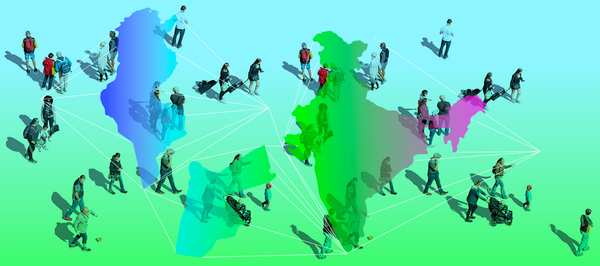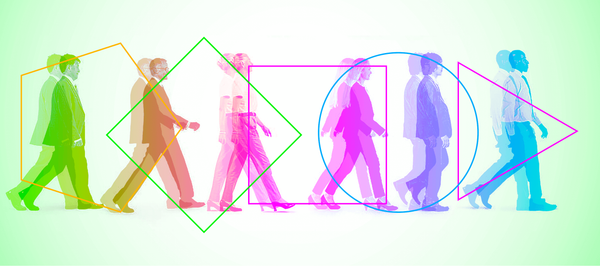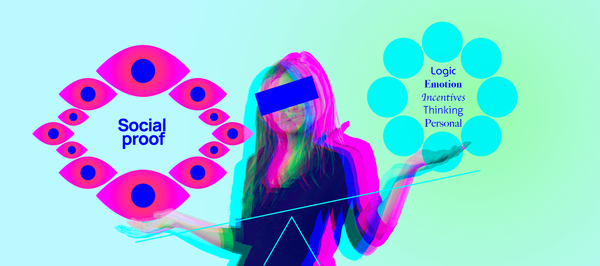What is a global team? One way to define it could be saying it is a team that works globally—all across the planet—or that the team represents the globe by comprising people from many corners of the world.
Surely, that sums up what a global team is. But does it?
For us, that answer does not cover it. Building a global team is much more complicated than just hiring people with different passports to work in different countries.
In this article, we speak from the perspective of our experience at Busara. Busara thinks of itself as a behavioral research organization with a Global South identity: we work and primarily live in the Global South. We aim to produce research informed by behavioral approaches that reflect deep contextual knowledge. Our goal is for that knowledge to lead to better policies and programs that fall under the broad heading of international development.
Building a global team requires appreciating the subtext of terms such as “global” and “international,” as well as the origins of dominant ways of thinking in this sector. It requires revisiting what categories an organization uses—such as looking at nationality or living location—to create diversity and inclusion.
Often underappreciated in this categorization exercise is that the location of where someone received tertiary education might be a crucial determinant in how they experience their role in a knowledge creation effort. We also suggest that building a global team needs to focus on “boring” stuff, including policies, processes and the everyday practice of inclusion and diversity.
Loaded Terminology
In international development, the term “global” carries subtext, as does the term “international.” Not everyone is part of a big global family. Some internationals are more international than others.
For example, some funders do not consider an organization “international” unless it is headquartered in Europe or North America. Everyone else is “regional,” no matter how far and wide their offices are spread across the globe (in our case India, Kenya, Nigeria, Tanzania, Uganda). This points to the need to unpack some power dynamics that underpin the notion of globality and internationalism.
Recently, scholars have suggested moving away from the descriptor of “international development” (which suggests that development is most needed in a set of previously called ‘developing countries) to using terminology of “global development” to denote that inequalities are a problem not just between countries, but within countries—including those that were previously considered the set of “developed” countries (Horner & Hulme, 2017). This shift in terminology might be helpful in foregrounding the shared challenge.
Yet, for the purpose of highlighting deeply historical inequities, the term “global” has also been qualified in other ways. Terminology of Global North and Global South draws a dividing line not along the equator, but along the historical role played by a country. The Global North, in this definition, represents the countries whose histories are those of conquering and imperialism and which today sit on the upper end of the Human Development Index (HDI). That is why, for example, New Zealand, usually in the southernmost corner of the world map, is part of the Global North.
The Global South comprises the countries populating the lower ranks on the HDI: the countries that were conquered and explored for the development of others. That is why Haiti, in the northern hemisphere, in this classification is part of the Global South. There is no even split between the imaginary hemispheres: 85% of the world’s population lives in the Global South, making this the majority category (World Population Review, 2023).
So, is a global team one that represents people from either imagined hemisphere? Or is there more we need to consider?
There is more.
The term “global” is deceptive. It suggests an equal coexistence on the same planet. Yet it is not a unifying adjective. While the terminology Global North / Global South is now widely used, it is often done without unpacking the implications of it—such as the fact that it hides inequalities within these categories or carries a subtext (Haug et al., 2021).
For us, to build a global team means to speak openly about power, about representation, about knowledge hierarchies and how they influence the research work we do—and about how to counter the status quo of these through deliberate processes. Rather than leveling differences, the descriptor “global” can also highlight them. We need to bring these differences into the foreground when building global teams.
Why Global Development Struggles to Build Global Teams
Development should be inherently global, inclusive and international. In recent years, there has been increased emphasis on it being locally led (Smith, M., 2022). This is easier said than done.[1] What exactly development is or what is beneficial for people is still primarily decided in countries that are not the target of development programs. Research for international development continues to be commissioned through funding mechanisms that prioritize international organizations over the so-called regional ones.[2]
In this hierarchy and resource pyramid, it is still commonly the case that research steps are split up in a specific way. An international team (with a headquarter in the Global North) designs the research and owns the analysis, while data collection is done by a team national to the Global South country in which the research is conducted.
Of course, there can be nationals of different countries on either team, but this does not challenge the dynamic. While there is both an articulated and unspoken consensus that this is not right, the reality has remained unchanged.[3] Why?
One reason might be because research efforts or other development work are currently not supported by genuine efforts to build global teams. Building global teams goes beyond balancing between the national and international staff categories. It must start by analyzing how power manifests itself in hiring for international development work. It must also recognize which identity categories are relevant for the diversity the team needs to represent.
Right now, global teams are often characterized through crude categorizations. If you are local to a Global South country, you are adding to diversity within an international team. But this kind of diversity thinking does not shift the underpinning power dynamics with which development struggles: Global South and Global North team members hold different kinds of power. Right now, Global North knowledge interests continue to rule because they support maintaining ways of working and funding in international development that uphold the existing power dynamics.
The international development sector, while full of well-intentioned people, continues to be quite homogenous in whom it represents in its team and the beliefs they uphold, including what it considers rigorous and viable ways of knowledge creation. The roots of this go deep and can be found in entrenched knowledge hierarchies.
The Role of Knowledge Hierarchies
International development might be uncomfortable with its imperial background. But tackling knowledge hierarchies requires acknowledging that bettering people and unpacking their lives through research has deep colonial roots, (Smith, L.T., 1999) and is also anchored in a mental model that prioritizes transactions and economic growth, which reflects capitalist and usually neoliberal approaches (Schomerus, 2023). Knowledge production continues to celebrate particular ways of knowing or solving a development problem that follow Western or Global North traditions, which then reinforce global power relations (Grewal, 2001).
University cultures in the Global North dominate definitions of what makes up knowledge and good research. These definitions often exclude the narratives or ways of knowing of scholars (i.e., other manifestations of what constitutes research) or ordinary people from the Global South (Medin et al., 2017). In fact, the dominance of ideas is so strong that it can seem impossible for those from the Global North to imagine that there are different ways of knowing, of being, or of asking and answering questions than the one they favor.
Many people working in development are deeply conditioned to think the world works only in one particular way because of who they are. Often from a background that Henrich et al. (2010) have so memorably called WEIRD, they are from countries that are Western, Educated, Industrialized, Rich, and Democratic (WEIRD).
Coming from this background, argues Henrich, means carrying a legacy of centuries of rule and institution-building that has deep influences on social structures and economic systems, but was not mirrored in non-WEIRD countries, which often continue to be kinship-based (Henrich, 2020). The notion of the WEIRD person primarily teaches us how deeply our origins condition us, which translates into the role a person plays in a global team.
However, there is an imbalance here: while WEIRD perspectives dominate global narratives and mental models of international development, numerically, WEIRD people are the minority. This is why we must prioritize hiring with an acute awareness of backgrounds. We must ask ourselves: what has shaped a person? Are they attractive to the global team because they are from the place in which development work is to be implemented and because they are fluent in WEIRD work cultures and mental models of international engagement, thus making them an easier team member for colleagues from Global North countries?
This is reminiscent of Fanon’s (1967) argument about Africans learning another language (in Fanon’s argument, French) “because it is the key that can open doors” but is also “evidence of dislocation, a separation” — but a separation that serves the purpose of Global North-driven development narratives (Fanon, 2016).
Is the purpose to hire someone who can seem representative, or to hire someone who can push development practitioners to make their work context specific and locally owned? Someone who can challenge knowledge production in, for example, Africa with queries about what research requiring context seriously means? Someone who recognizes the need for a new contextually relevant type of research, rather than building capacity to produce research in the image of traditions from elsewhere?
Answering these questions requires rethinking diversity towards establishing relevant (and maybe not obvious) categories.
Rethink Diversity Along Relevant Categories to Create a Global Team
In hiring for international development research, the language of diversity and inclusion usually represents an attempt to acknowledge differences and the need to create a team that has different kinds of connections to the people being researched.
A prominent manifestation of diversity approaches is thus to hire local people (whose nationality matches their workplace) and have them represent different categories like gender, race, age, or ethnic background. However, this crude categorization (which is replicated in how the international development community targets its so-called beneficiaries) comes with various definitional and managerial challenges (Schomerus, 2023). Teams that are put together based on these categories might not represent the work they are supposed to do.
We thus have been rethinking diversity and inclusion as relevant to the work we aim to do: produce knowledge that is behaviorally informed, contextual, localized and relevant to the lived experience of the people being studied (who are in the Global South), while still usable for global development (which works off of ideas rooted in the Global North).
Building a global team requires being completely transparent about these differences. This has to start with an operationally relevant definition of what diversity is for an organization that wants to conduct research in context-specific and appropriate ways while still creating deep knowledge. But it requires moving beyond categorizing people by their geographical origin to also recognize the particular path that an individual has taken.
Sometimes, this path represents considered choices. Sometimes this path means taking whatever opportunities were available. Having been able to make a considered choice is a marker of privilege, and it is a privilege most often held by Global North staff.
Within a global team, Global North staff usually have options. Based on their backgrounds, they made a conscious decision to work in a global context (usually meaning away from their home country) and to apply their skills in an environment foreign to them. Being global with this background is often a value-driven lifestyle choice.
Staff from the Global South, however, become part of a global team as a recipient of the globality of the organization. They are the local hires that are expected to bring the credibility of local knowledge. They have less of a choice of being a global team. They are just hired into one that thinks of itself in this way. Being in a global team with this background is often a livelihood-driven matter, which creates a unique relationship to the work.
This crucial difference means that within one global team, people are on very different footing. This difference needs to be spelled out and its implications must be understood.
Identity and Backgrounds Matter
During the hiring process, several identity factors play a role when seeking to build a global team, including:
- Demographic identities such as country of origin, race, gender, and even religion
- Educational background, including the type of degree obtained and at which educational institutions
- Experience or the number of years working in the relevant field for the position
These are all important elements, as staff will bring their demographic identities, their educational background, and their experience into the work.
This is, however, where we have learned to question our assumptions about broad-brushed categories and to realize that there are other parts to the identity of team members that require attention when building a global team. In an internal exploration of our organizational identity, we realized that beyond country of origin, race, gender, age, ethnicity, or experience, there is another marker that deeply matters; where you were educated. This intersects with geographical origin in ways that deeply influence a person’s perspective on their work and how to conduct it.
In an internal explorative research project, we looked at how the makeup of the team at Busara supported or hindered the ability to produce contextualized research. This question led to the examination of the meaning of the term Global South as a foundation of Busara’s identity and how this shapes the team and their view of the work they do.
We realized we needed to look at how to introduce the categories of Global North and Global South into our thinking on diversity and global teams. In this examination, we categorized people into Global North (GN) and Global South (GS)–meaning where they were born and grew up as a relatively average member of that society.
A striking difference was in how people thought of themselves in relation to their work. GN staff members described themselves through their values and educational accomplishments. They work in international development research because they believe in the mission and thus made a choice to do so.
However, GS staff broadly used their ethnic identity, country of citizenship, and gender to describe themselves and highlighted that their origin made development challenges personal to them. They think of their work in terms of context, social norms, family traditions, and their own culture and habits. The value-based identity of GN seems rooted within an abstraction of the problems their research seeks to address, while the location-based identity of GS staff has developed from lived experience.
We further looked at what we considered a crucial intersection: whether someone is GN or GS and whether someone was educated (primarily in tertiary education) in the Global North or the Global South. This helped us create three identity categories that we came to recognize as crucial when build a global team:
- Global North staff educated in the Global North (GNGN)
- Global South staff educated in the Global North (GSGN)
- Global South staff educated in the Global South (GSGS).
In a clear nod to global power dynamics and prioritization of certain types of knowledge, we did not have anyone who fit the category of Global North educated in the Global South (GNGS).
We learned that people from the three intersectional categories approach their work with different intentions, values and even understandings of their own identity and contribution to knowledge creation. GSGS use their academic training to create contextualized knowledge, while GNGN use their academic accomplishments to ensure technical rigor in research.
Though both points of references are needed for good research, a global team requires valorization of both contributions in equal ways. This does not happen automatically because of the existing power dynamics that think of expertise as something that is learned in educational establishments, while local knowledge is gained by being from a particular place and thus somewhat anecdotal.
The implication is that GSGS staff members experienced their localized educational background being deemed less relevant for decisions on research designs, where technical rigor imparted through education in the Global North ultimately won out. GSGN often sit in the middle. They are viewed by outsiders as a local diversity hire, but are deeply rooted in their GS context, while having been shaped by a GN education and particular version of values and beliefs.
How might this play out in practice?
Imagine a research team working in a Global South country is tasked with research that informs a new program to empower women by getting them employed in jobs. What perspectives might the different researchers bring to this somewhat reductive scenario? GNGN might be so focused on the technical questions of the research design that questioning the underlying mental model does not occur. Plus, they might be more aware of the growing interest in studying gender empowerment. The World Bank, the largest supplier of development capital, commits millions per year to projects that aim to close this gender gap, so studying it seems to be supported by more than just intellectual trends (World Bank, 2013).
GSGN might have experienced the contradictions between how they experience life at home and what they were taught in Global North universities. They might recognize that the underlying assumption of the proposed empowerment program is informed by a notion of the family structure that is central to capitalist means of production, where women’s empowerment is imagined through levels of education and participation in the labor market (Radhakrishnan & Solari, 2015).
GSGS might know this is unlikely to actually empower women because they have never seen that the concept of employment-driven empowerment has meaning in, for example, most African countries that are not as industrialized as America and Europe. They might have a hunch that the capitalist Western ideology of empowerment takes a space away from African narratives of empowerment that have little to do with the labor market.
In this example, international development research suffers from a lack of genuinely seeking to make research and solutions to problems locally owned.
Inclusion and diversity in a truly global team must mean that these dynamics are brought out in the open, including the culturally driven behavior that comes with these categories. In our organization, which was founded after GN models and with GN founders, certain characteristics—such as being outspoken—are valued. These are often not that easy to fulfill for GSGS, whose cultures place more value on respectful behavior and less value on dissent and debate, and the nuances in which debates and discussions occur in different cultures.
Within this set-up, often GSGN are intrinsically fulfilling the role of translators, implicitly knowing how open feedback and outspoken critique are atypical and often highly uncomfortable in a GS context but having honed their communication skills through a GN education, thus widening the channels for discussion and generating verbal contributions. However, it is a role that can be exhausting—and not necessarily strategic—to play.
These elements are important when building a global team. Behavioral scientists know the impact of people feeling alienated.
Staying within a GN outlook, we can see the issue that arises when these dynamics are not brought out into the open and then addressed as a productivity challenge. Those dynamics include:
- Feeling alienated.
- Feeling as if one is working under an inappropriate ideology.
- Failing to recognize that there are different identity-based categories of valorization that can make people less effective, efficient, or interested in their work.
Not putting in the effort to understand what makes a genuinely exclusive global team creates productivity issues for the team.
Conclusion & Key Points
Building a global team might sound like quite a flashy undertaking. That flashy image is fueled by the imagination of what international means that calls up GN-influenced images of different countries and travel. In this imagery, the hiring process is the end point of the attempt to build a diverse team.
Once we have enough women, we are diverse. Once we have enough people from the place where we are working, we are contextual. Once we have enough technical experts that bring rigor, we can produce good research. Positive answers to this often come at the end of the team-building exercise.
But to create diverse, inclusive teams, the hiring process should be the starting point of the practice of global team building. A truly global team cannot start from the international imagery. Rather, to build a global (and with that diverse) team requires all the things that on paper look boring, like:
- Asking questions
- Understanding how background influences choice and thus the relationship to work
- Understanding how identity (and not feeling recognized) can alienate people and diminish certain voices while working together
Diversity is a never-ending process, and it requires commitment to intentionally and consistently shape an inclusive environment that acknowledges the power dynamics between GN and GS as well as the more nuanced GNGN, GSGN, and GSGS categories.
Each identity might have different limitations. GNGN might mostly operate from an academic, theoretical perspective. GSGS might offer the richest contribution in terms of context and lived experiences when producing knowledge on and in the Global South. Achieving diversity comes from everybody acknowledging the contribution of the other. The presence of all categories produces quality, contextually knowledgeable research.
Below are suggestions for practices that could be transformative when building global teams to conduct research for international development. They point towards human resources policies and bureaucratic decisions, but they are only seemingly boring. They are the scaffolding on which a genuine commitment to global teams hangs.
-
Hiring practices.
How do people actually get hired for a job? What is the role of membership of specific networks and how does one gain access to these networks? Who gets to jump several steps in the hiring process simply because of who they are, who they know, or how they expect the hiring process to go, based on their backgrounds?
-
Pay practices.
Teams with people from different origins tend to somehow acknowledge that difference through pay. In a truly global team, what does equal pay mean for GN and GS staff, or for staff in different regions or countries within the same hemisphere?
-
Benefit practices.
What work benefits are open for GN and GS staff without reducing their work value? How do different living situations create different needs? For example, what staff members would like to see an organization spend money on a Christmas party versus paying a bonus (however small) that can be used for family Christmas expenses?
-
Organizational cultural practices.
How are differences spoken about in the organization? What does language and settling on how terminology is used across an organization mean? How are the boring procedural elements that create the possibility of diversity and inclusion lived every day? Are mentoring systems in place? Do they allow mentoring of staff members in different perspectives? For example, can a junior GSGS staff mentor a senior GNGN staff, or are there unspoken power differences that stand in the way of learning?
Frank and continuous reflection on these questions goes a long way towards understanding what it will take to build truly global teams. Such a team does not simply take a differentiating notion of global as a given and does not think of the term “international” as glitzy and thus requiring little reflection. A global team does not dwell on passports or simplistic identity categories but pays attention to the paths of life that brought someone to the team.
References
- Craney, A., & Hudson, D. (2020). Navigating the dilemmas of politically smart, locally led development: the Pacific-based Green Growth Leaders’ Coalition. Third World Quarterly, 41**,** 1653-1669.
- Reidpath, D.D., & Allotey, P. (2019). The problem of ‘trickle-down science’ from the Global North to the Global South. BMJ Global Health, 4(4), e001719.
- Fanon, F. (2016). Black skin, white masks. In Social Theory Re-Wired (pp. 394-401). Routledge.
- GREWAL, G. 2001. In Uma Narayan, dislocating cultures: Identities, traditions, and third-world feminism. New York, Routledge, 1997. Hypatia, 16.
- Haug, S., Braveboy-Wagner, J., & Maihold, G. (2021). The ‘Global South’in the study of world politics: examining a meta category. Third World Quarterly, 42(9), 1923-1944.
- Henrich, J. (2020). The Weirdest People in the World: How the West Became Psychologically Peculiar and Particularly Prosperous, New York, NY, Penguin (Farrar, Straus and Giroux).
- Henrich, J., Heine, S. J., & Norenzayan, A. (2010). The weirdest people in the world?. Behavioral and Brain Sciences, 33(2-3), 61-83.
- Horner, R. & Hulme, D. (2017) From international development to global development. http://blog.gdi.manchester.ac.uk/from-international-development-to-global-development/.
- Ingram, G. (2022). Locally driven development: Overcoming the obstacles (Brookings Global Working Paper #173), Washington, D.C., Brookings Institution.
- Kaya, H.O. & Seleti, Y.N. (2013). African indigenous knowledge systems and relevance of higher education in South Africa. The International Education Journal: Comparative Perspectives, 12**,** 30–44.
- Medin, D., Ojalehto, B., Marin, A. & Bank, M. (2017). Systems of (non-)diversity. Nature Human Behavior, 1**,** 0088.
- Olufadewa, I., Adesina, M. & Ayorinde, T. (2020). From Africa to the World: Reimagining Africa's research capacity and culture in the global knowledge economy. Journal of Global Health, 10.
- Radhakrishnan, S. & Solari, C. (2015). Empowered women, failed patriarchs: Neoliberalism and global gender anxieties. Sociology Compass, 9**,** 784–802.
- Schomerus, M. (2023a). Lives Amid Violence: Transforming Development in the Wake of Conflict, London, Bloomsbury.
- Schomerus, M. (2023b). A satellite image of the neighborhood: how who you are matters. Lives Amid Violence: Transforming Development in the Wake of Conflict. London: Bloomsbury.
- Congressional Research Service. (not dated). CHECK THIS TITLE, Retrieved December 8, 2022, from https://sgp.fas.org/crs/misc/R44283.pdf
- Smith, L.T. (1999). Decolonizing Methodologies: Research and Indigenous Peoples. London, Zed Books.
- Smith, M. (2022). What Locally Led Development Means to Us. https://www.workwithusaid.org/blog/what-locally-led-development-means-to-us.
- World Bank. (2013). CHECK Gender at the World Bank Group. World Bank. https://www.worldbank.org › content › dam › Worldbank › document › Gender › Gender Board Update 2013
- World Bank. (not dated). CHECK Research and development expenditure (% of GDP). Data. (n.d.). , Retrieved December 8, 2022, from https://data.worldbank.org/indicator/GB.XPD.RSDV.GD.ZS
- World Population Review. (2023). Global South Countries [Online]. https://worldpopulationreview.com/country-rankings/global-south-countries: World Population Review.
See, for example, Ingram (2022), and Craney & Hudson (2020). ↩︎
This is exacerbated by the fact that national spending on research differs drastically: Global spending on Research and Development (R&D) was around $2.7 trillion in 2020, but only ten Global North countries dominated the knowledge production, accounting for 85% of the global total (Congressional Research Service, 2022). The majority of African countries spent less than 1% of their gross domestic product on R&D (World Bank, not dated). While this does not mean that the research conducted under Global North auspices was conducted elsewhere, this nonetheless skews what is considered acceptable knowledge and research approaches, as it is so driven by Global North perspectives. ↩︎
See, for example, Olufadewa et al. (2020) and, Reidpath & Allotey (2019). ↩︎





